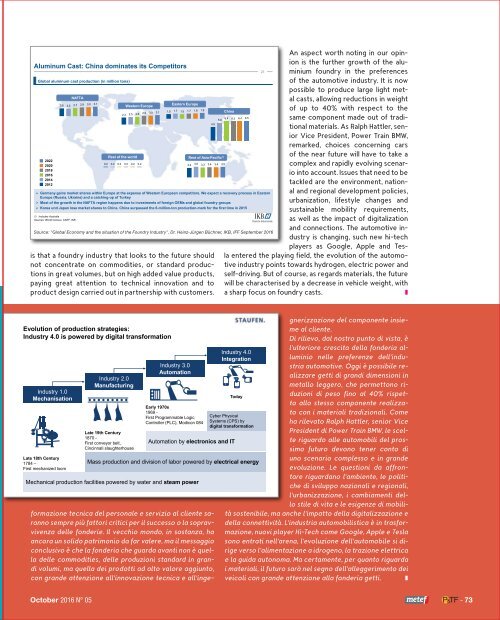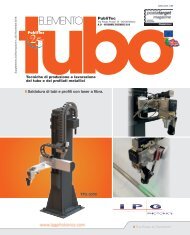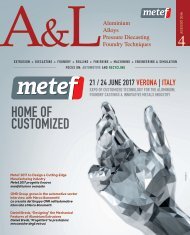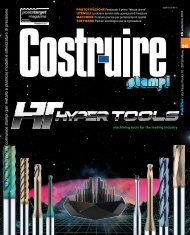AL_n5_OTTOBRE_2016
Create successful ePaper yourself
Turn your PDF publications into a flip-book with our unique Google optimized e-Paper software.
0070-0073 4<br />
Aluminum Cast: China dominates its Competitors<br />
Global aluminum cast production (in million tons)<br />
2022<br />
2020<br />
2018<br />
<strong>2016</strong><br />
2014<br />
2012<br />
‣ Germany gains market shares within Europe at the expense of Western European competitors. We expect a recovery process in Eastern<br />
Europe (Russia, Ukraine) and a catching-up of Turkey<br />
‣ Most of the growth in the NAFTA region happens due to investments of foreign OEMs and global foundry groups<br />
‣ Korea und Japan lose market shares to China. China surpassed the 6-million-ton production-mark for the first time in 2015<br />
1) Includes Australia<br />
Sources: World Census, CAEF, IKB<br />
NAFTA<br />
2.6 2.5 2.7 2.9 3.0 3.1<br />
Western Europe<br />
Eastern Europe<br />
2.3 2.5 2.6 2.9 3.0 3.1 1.5 1.7 1.5 1.7 1.8 1.9<br />
Rest of the world<br />
0.2 0.2 0.2 0.2 0.2 0.2<br />
Rest of Asia-Pacific 1)<br />
isthatafoundryindustrythatlookstothefutureshould<br />
not concentrate on commodities, or standard productions<br />
in great volumes, but on high added value products,<br />
paying great attention to technical innovation and to<br />
product design carried out in partnership with customers.<br />
3.2<br />
4.5<br />
5.9<br />
3.6 3.3 3.4 3.4 3.5<br />
China<br />
6.4 6.3 6.4 6.5<br />
Source:"GlobalEconomyandthesituationoftheFoundryIndustry",Dr.Heinz-JürgenBüchner,IKB,IFFSeptember<strong>2016</strong><br />
23<br />
Anaspectworthnotinginouropinion<br />
is the further growth of the aluminium<br />
foundry in the preferences<br />
of the automotive industry. It is now<br />
possible to produce large light metal<br />
casts, allowing reductions in weight<br />
of up to 40% with respect to the<br />
samecomponentmadeoutoftraditional<br />
materials. As Ralph Hattler, senior<br />
Vice President, Power Train BMW,<br />
remarked, choices concerning cars<br />
of the near future will have to take a<br />
complex and rapidly evolving scenario<br />
into account. Issues that need to be<br />
tackledaretheenvironment,national<br />
and regional development policies,<br />
urbanization, lifestyle changes and<br />
sustainable mobility requirements,<br />
as well as the impact of digitalization<br />
and connections. The automotive industry<br />
is changing, such new hi-tech<br />
players as Google, Apple and Tesla<br />
entered the playing field, the evolution of the automotiveindustrypointstowardshydrogen,electricpowerand<br />
self-driving.Butofcourse,asregardsmaterials,thefuture<br />
will be characterised by a decrease in vehicle weight, with<br />
asharpfocusonfoundrycasts.<br />
❚<br />
Evolution of production strategies:<br />
Industry 4.0 is powered by digital transformation<br />
Industry 1.0<br />
Mechanisation<br />
Late 18th Century<br />
1784 –<br />
First mechanized loom<br />
Industry 2.0<br />
Manufacturing<br />
Late 19th Century<br />
1870 -<br />
First conveyor belt,<br />
Cincinnati slaughterhouse<br />
Industry 3.0<br />
Automation<br />
Early 1970s<br />
1969 -<br />
First Programmable Logic<br />
Controller (PLC), Modicon 084<br />
Cyber Physical<br />
Systems (CPS) by<br />
digital transformation<br />
Automation by electronics and IT<br />
Mass production and division of labor powered by electrical energy<br />
Mechanical production facilities powered by water and steam power<br />
Industry 4.0<br />
Integration<br />
Today<br />
formazionetecnicadelpersonaleeservizioalclientesaranno<br />
sempre più fattori critici per il successo o la sopravvivenza<br />
delle fonderie. Il vecchio mondo, in sostanza, ha<br />
ancoraunsolidopatrimoniodafarvalere,mailmessaggio<br />
conclusivo è che la fonderia che guarda avanti non è quella<br />
delle commodities, delle produzioni standard in grandi<br />
volumi, ma quella dei prodotti ad alto valore aggiunto,<br />
con grande attenzione all’innovazione tecnica e all’ingegnerizzazione<br />
del componente insieme<br />
al cliente.<br />
Dirilievo,dalnostropuntodivista,è<br />
l’ulteriore crescita della fonderia alluminio<br />
nelle preferenze dell’industria<br />
automotive. Oggi è possibile realizzare<br />
getti di grandi dimensioni in<br />
metallo leggero, che permettono riduzioni<br />
di peso fino al 40% rispetto<br />
allo stesso componente realizzato<br />
con i materiali tradizionali. Come<br />
ha rilevato Ralph Hattler, senior Vice<br />
President di Power Train BMW, le scelte<br />
riguardo alle automobili del prossimo<br />
futuro devono tener conto di<br />
uno scenario complesso e in grande<br />
evoluzione. Le questioni da affrontare<br />
riguardano l’ambiente, le politiche<br />
di sviluppo nazionali e regionali,<br />
l’urbanizzazione, i cambiamenti dellostiledivitaeleesigenzedimobili-<br />
tàsostenibile,maanchel’impattodelladigitalizzazionee<br />
della connettività. L’industria automobilistica è in trasformazione,<br />
nuovi player Hi-Tech come Google, Apple e Tesla<br />
sono entrati nell’arena, l’evoluzione dell’automobile si dirige<br />
verso l’alimentazione a idrogeno, la trazione elettrica<br />
e la guida autonoma. Ma certamente, per quanto riguarda<br />
imateriali,ilfuturosarànelsegnodell’alleggerimentodei<br />
veicoli con grande attenzione alla fonderia getti. ❚<br />
October <strong>2016</strong> N° 05<br />
- 73





